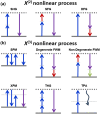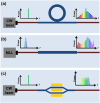Nonlinear photonics on integrated platforms
- PMID: 39634844
- PMCID: PMC11614347
- DOI: 10.1515/nanoph-2024-0149
Nonlinear photonics on integrated platforms
Abstract
Nonlinear photonics has unveiled new avenues for applications in metrology, spectroscopy, and optical communications. Recently, there has been a surge of interest in integrated platforms, attributed to their fundamental benefits, including compatibility with complementary metal-oxide semiconductor (CMOS) processes, reduced power consumption, compactness, and cost-effectiveness. This paper provides a comprehensive review of the key nonlinear effects and material properties utilized in integrated platforms. It discusses the applications and significant achievements in supercontinuum generation, a key nonlinear phenomenon. Additionally, the evolution of chip-based optical frequency combs is reviewed, highlighting recent pivotal works across four main categories. The paper also examines the recent advances in on-chip switching, computing, signal processing, microwave generation, and quantum applications. Finally, it provides perspectives on the development and challenges of nonlinear photonics in integrated platforms, offering insights into future directions for this rapidly evolving field.
Keywords: frequency combs; integrated photonics; nonlinear photonics; supercontinuum generation.
© 2024 the author(s), published by De Gruyter, Berlin/Boston.
Conflict of interest statement
Conflict of interest: Authors state no conflict of interest.
Figures

















References
-
- Franken P. A., Hill A. E., Peters C. E., Weinreich G. Generation of optical harmonics. Phys. Rev. Lett. . 1961;7(4):118. doi: 10.1103/physrevlett.7.118. - DOI
-
- Boyd R. W., Gaeta A. L., Giese E. Springer Handbook of Atomic, Molecular, and Optical Physics . New York: Springer; 2023. Nonlinear optics; pp. 1097–1110.
-
- Malvezzi A., et al. Resonant second-harmonic generation in a GaAs photonic crystal waveguide. Phys. Rev. B . 2003;68(16):161306. doi: 10.1103/physrevb.68.161306. - DOI
-
- Shen Y. R. Surface properties probed by second-harmonic and sum-frequency generation. Nature . 1989;337(6207):519–525. doi: 10.1038/337519a0. - DOI
Publication types
LinkOut - more resources
Full Text Sources
